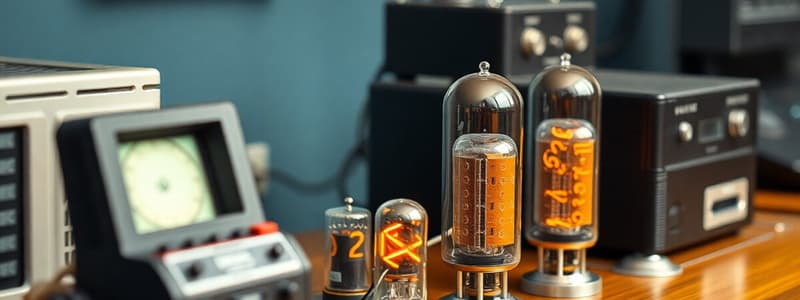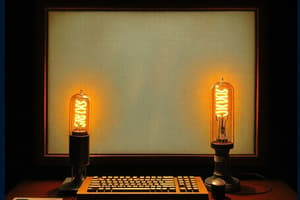Podcast
Questions and Answers
What was a significant characteristic of first generation computers?
What was a significant characteristic of first generation computers?
- Incorporation of high-level programming languages
- Reliance on vacuum tubes and magnetic drums (correct)
- Use of transistors for memory
- Operating at a processing speed of 1 million instructions per second
Which of the following was NOT a characteristic of the second generation of computers?
Which of the following was NOT a characteristic of the second generation of computers?
- Reliance on transistors for operations
- Introduction of high-level programming languages
- Use of vacuum tubes for internal operations (correct)
- Processing speed improvement to 1 million instructions per second
During which generation was the integrated circuit introduced as the major hardware feature?
During which generation was the integrated circuit introduced as the major hardware feature?
- Third Generation (correct)
- First Generation
- Second Generation
- Fourth Generation
What programming language development occurrence happened in the second generation?
What programming language development occurrence happened in the second generation?
What was a challenge faced by first generation computers?
What was a challenge faced by first generation computers?
Flashcards
First Generation Computers
First Generation Computers
Computers built using vacuum tubes and magnetic drums, characterized by slow processing speeds, large size, and limited memory capacity.
Second Generation Computers
Second Generation Computers
Computers built using transistors and magnetic core memory, offering significantly faster processing speeds, smaller size, and enhanced memory capacity compared to their predecessors.
Third Generation Computers
Third Generation Computers
Computers utilizing integrated circuits (ICs) or chips, resulting in even faster processing speeds, reduced size, and increased memory capabilities.
Vacuum Tubes
Vacuum Tubes
Signup and view all the flashcards
Transistors
Transistors
Signup and view all the flashcards
Study Notes
Computer Generations
- First Generation (1946-1958):
- Computers used vacuum tubes and magnetic drums for processing.
- Processing speed was 1,000 instructions per second.
- Size was limited to mainframes.
- Memory capacity was limited.
- Programming language was machine language (0s and 1s).
- Input used punch cards and paper tape.
- Output was printouts.
- Examples include UNIVAC (first commercial business computer), IBM 701.
- Operation was expensive and generated significant heat, leading to frequent malfunctions.
Second Generation (1959-1964)
- Major hardware features included transistors and magnetic core memory.
- Increased processing speed to 1 million instructions per second.
- Size remained mainframe.
- Increased memory capacity.
- Replaced vacuum tubes with transistors.
- Examples include UNIVAC 2, IBM 7030/7070/7090, 1400 series, RCA 501, Philco Transac S-200 and NCR 300 series.
- Transistors replaced 40 vacuum tubes with one. This resulted in smaller, faster, cheaper, and more energy-efficient computers.
- Still significant heat generation.
- Used assembly language (e.g., ADD, SUB, LD) for easier programming than machine language.
- Input and output still used punch cards and printouts.
- Introduced magnetic tape and discs for storage, also a reduction in heat generation compared to first generation.
Third Generation (1965-1970)
- Major hardware feature was the integrated circuit (IC) or chip.
- Processing speed increased to 10 million instructions per second.
- Size reduced to mini computers.
- Significantly increased memory capacity.
- Integrated circuits replaced transistors.
- Increased speed and efficiency.
- Transition to keyboard and monitor for input/output.
- Introduced operating systems enabling multiple applications.
- Increased accessibility and mass production.
- Development of the software industry.
- Reduction in size and cost, making computers accessible to a wider audience.
Fourth Generation (1971-Present)
- Major hardware features included 100,000 components on a chip.
- Processing speed increased to 100 million instructions per second.
- Sizes included mainframes, mini, and micro computers.
- Developed microprocessors, leading to microcomputers and supercomputers.
- Examples include Apple 2, TRS-80, IBM System 370/390, IBM PC XT/80, Motorola 6803.
- Development of personal computers (e.g., IBM's first home computer 1981, Apple Macintosh 1984).
- Networks and the internet emerged.
- Introduced the mouse and graphical user interfaces (GUIs).
- Large-scale integration (LSI) allowed thousands of components on a single chip.
- Emergence of user interfaces.
- Microcomputers and supercomputers became more common.
Fifth Generation (Present and Beyond)
- Goal is AI-powered devices responding to natural language input, learning, and self-organization.
- Applications include voice recognition.
- Uses of parallel processing and superconductors; quantum computation and nanotechnology will impact computers in the future.
- Moore's Law describes the exponential increase in circuit capacity.
- Development of artificial intelligence is the main goal.
Studying That Suits You
Use AI to generate personalized quizzes and flashcards to suit your learning preferences.




